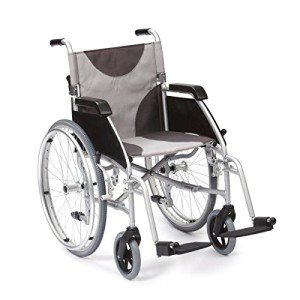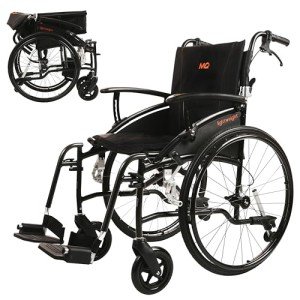What's The Current Job Market For Self Propelled Wheelchair Profession…
페이지 정보
작성자 Maddison 작성일 25-01-23 22:54 조회 13 댓글 0본문
 self propelled wheelchair uk Propelled Wheelchair With Attendant Brakes
self propelled wheelchair uk Propelled Wheelchair With Attendant BrakesSelf propelled wheelchairs with brakes that are attendant are a fantastic option for those who require additional support and stability while travelling. These chairs have rear drive wheels as well as a variety of optional accessories such as swing-away leg rests or flip-up armrests.
Unfortunately, there have been very few biomechanical studies of the turning and manoeuvring of attendant propelled wheelchairs. This is an area that requires further study.
Seat size
A wheelchair's seat width is the measurement of the distance from one end of the frame to the other. It is important to think about this when choosing the right chair, since different users will require different sizes. People with larger thighs, for example could require a wheelchair with an extra wide seat. To determine the right size, you must sit in the chair and take a measurement of the width of your thigh. A yardstick is generally the best choice, since it will help you get an accurate measurement.
The width of the seat on lightest self propelled wheelchair-propelled wheelchairs with brakes that are attendant is an important factor to consider, especially for caregivers. A wider seat will let the user move more comfortably and freely. This makes it easier for caregivers to maneuver the chair around tiny spaces. A lot of attendant controlled wheelchairs are light and have smaller wheels that allow for easy moving and pushing. This makes them ideal for people with limited upper body strength and coordination.
In addition to having a comfortable chair, a wheelchair must have brakes that are simple to use. These are important for ensuring safety while driving and when transferring. They also increase the occupants' autonomy and reduce stress. Research conducted at Dundee University has shown that the most effective brake system for wheelchairs is one that features a foot lever that can be easily accessed and used with one hand.
Unlike self-propelled wheelchairs, which have larger rear wheels and hand rims, attendant controlled wheelchairs have smaller wheels and are designed to be pushed by caregivers. These wheelchairs are ideal for those with limited upper body strength. They can also be easily moved and utilized in various environments. The majority of models come with cable brakes for increased the safety and comfort. Some even fold flat, making them ideal for storage and transportation in a car. Many models also emphasize comfort by offering features like cushioned armrests and seats.
Seat height
The seat height of a self propelled wheelchair with brakes that are included can vary significantly and must be carefully considered. The most comfortable position is a that is high enough to allow the occupant to sit up straight and unaffected by stress. However the height of the seat may also influence the amount of force required to push the wheelchair forward. This could have a significant effect on the performance of a wheelchair, and is especially important when a wheelchair has front-wheel drive.
The location of the handles for push can make all the difference in how easily the wheelchair can be pushed. The handles on the majority of wheelchairs are either horizontally across the back frame or as levers that extend backwards from the chair. Recent pushing studies have shown that these handle positions are not suitable for wheelchairs.
Many people use wheelchairs at home as well as in hospitals and other settings. Many of these people have difficulty walking and require assistance to move about. Attendants who are usually family members or close friends of the person who is wheelchair-bound might not be able to walk and have difficulty to maneuver wheelchairs indoors as well as outdoors. They may also have difficulty getting the person out of the wheelchair.
One of the most important issues for the attendant is the ability to maintain control of the wheelchair in an environment that is often uncontrolled. A wheelchair that is maneuverable is important, as are a wide set of wheels and puncture-proof tyres. A good castor trail (the distance between the wheel's axis and the handle holder's axes) is also essential for smooth riding.
The Ugo Esteem lightweight self folding mobility scooters electric self propelled wheelchair Propelled Wheelchair with Attendant Brakes what is the lightest self propelled wheelchair a great example of a well-designed wheelchair that is easy to push. It has a light aluminium frame with a 2-year frame warranty and puncture-proof tyres. It comes with adjustable armrests and footplates, as well as an option to elevate the leg rest (please select this from the drop-down list). The frame is compact and folds easily for easy transportation and storage.
Seat depth
The seat depth is a crucial factor in determining how easy it is to move a wheelchair. A seat that is deeper can stop the user from falling off of the chair. A seat that is too shallow can cause discomfort and injury. A wheelchair must have at least a 2 inch depth. This can provide enough clearance to avoid small obstacles and climb up kerbs.
In addition to the width of the seat, the height of the armrests and the seat are crucial in determining the appropriate size of the wheelchair for a specific user. A taller person will need a higher seat, and those who are shorter will require a smaller one. In addition that the wheelchair will be used to help with posture issues and backrest height should be higher than usual. This will make the wheelchair more comfortable for the user, Self Propelled Wheelchair and also allow them to sit upright.
The force applied to the wheels determines the roll resistance of a wheelchair. This force is dependent on the wheel's curvature radius and the condition of its surface. The wheels can be constructed to reduce their rolling resistance using soft rubber, which reduces the friction between the tire and the road, or by extending the rim width. The wheel's moment of inertia could be reduced by altering the design of the castor.
For instance for instance, the ugo Esteem Lightweight Self Propelled Wheelchair features a castor trail that is adjusted to meet the needs of the individual. This makes it easier to turn and less likely to shimmy while starting at rest. The adjustable footrest height and angle along with the seat cushion and the backrest make it more adaptable for each user.
You can determine the seat height of chairs by measuring the distance between the spine's base and the back of your knee. This measurement is typically taken by a caregiver in order to prevent injury to the wheelchair user. It is essential to determine whether the user requires an footrest and, if so, the height.
Armrests
Wheelchairs are often used by nursing staff in hospitals to move patients between departments and also as the main mode of transport for those patients who are not able to walk. Transferring patients in and out of wheelchairs can be an arduous task for attendants who have to lift them into and out each time, as well as pushing and manoeuvring the chair over a variety of terrain. The ergonomic design of these chairs should therefore strive to make propulsion as well as general operation as simple for attendants as is possible by minimising the physical demands on them. This means that the characteristics of handling the chairs, including their resistance to rolling, turning resistance, handle height, and the position of the brakes must be optimised biomechanically to maximise the comfort of the attendants.
The armrests of a self-propelled chair with brakes should be positioned properly to allow people who have strong arms to help themselves get out of the chair. They should also be able to be removed so that they do not hinder the access for those with greater disabilities when being lifted into the seat. The prototype chair made in Dundee had armrests that protruded to give support to the hands of users, and could fold down when not in use.
It is important that the chair is safe and comfortable, whether the user sits in it for a long time or just for a few minutes. The padded backrest and seat of this model are both upholstered with wipe clean nylon, which is strong and durable. The foot rests of this model can be moved and swung away to make transfers easier.
The light attendant controlled wheelchair has a range of helpful features for the caregiver or attendant, such as adjustable footplates, flip up, removable arm rests that aid in side transfers and help move them closer to tables and cable brakes to slow down speed and a step tube for climbing curbs. The backrest can be folded down for easy storage and transport. The lightweight wheelchair comes in two sizes and comes with a 12 month warranty as standard.

댓글목록 0
등록된 댓글이 없습니다.
